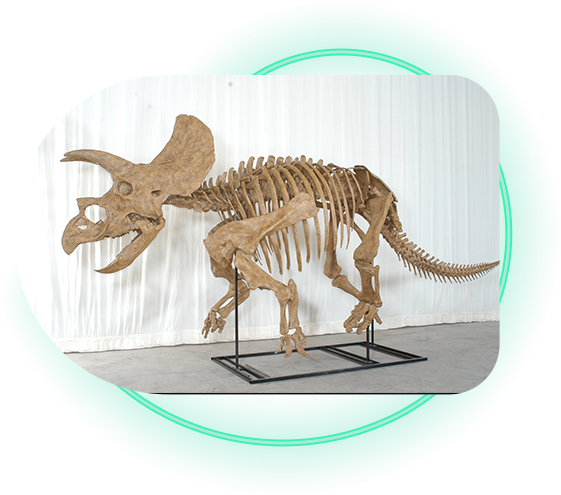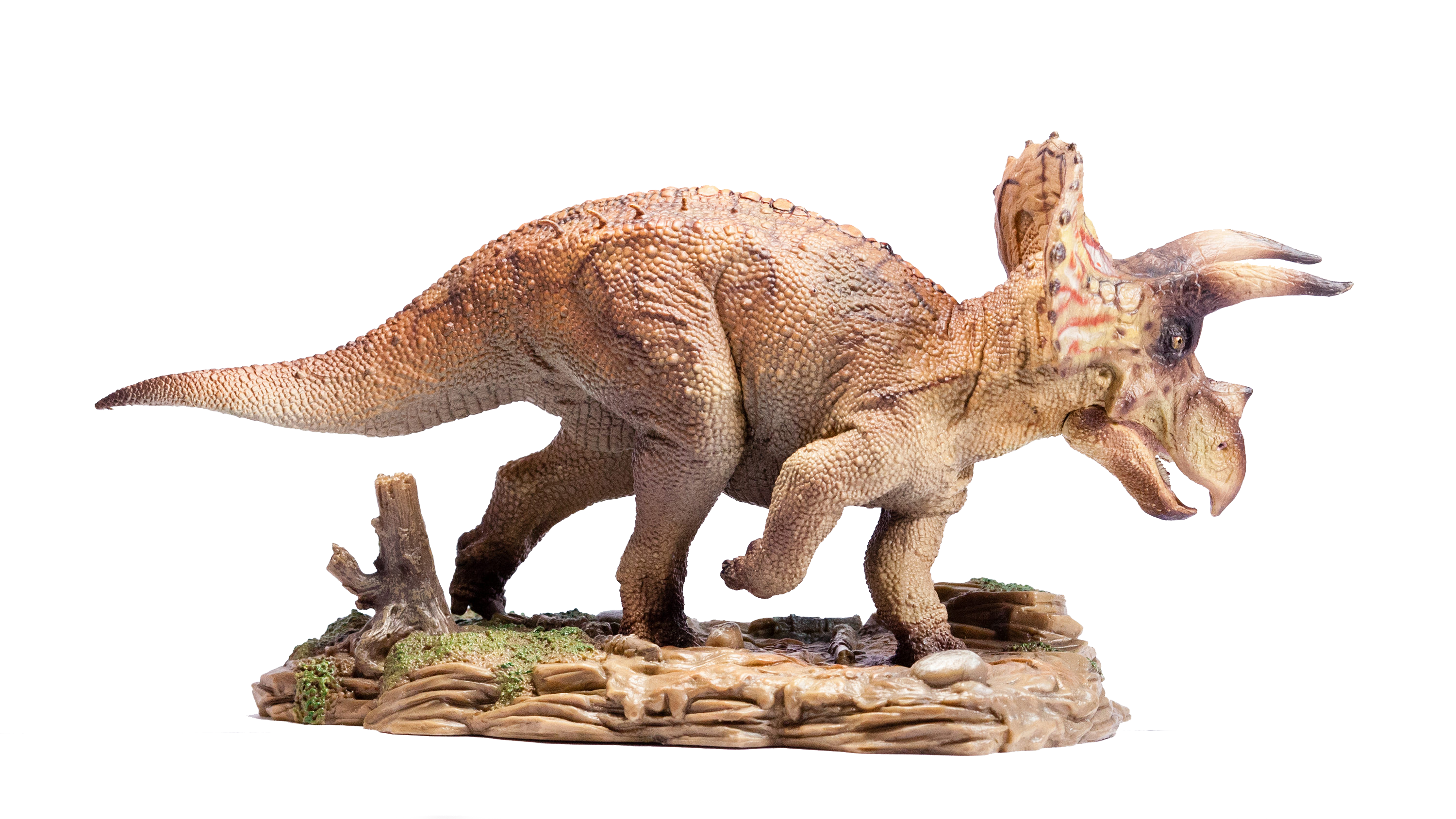Favorite CollLection Triceratops Real Figure Keyring
$11.95

What appears to be one of the three most complete Triceratops horridus skeletons known to science was excavated by Black Hills Institute staff from the Lance Creek fossil beds near Newcastle, Wyoming, in April of 1998. More than half of the Triceratops specimens presently known were excavated from these same fossil beds. This Triceratops was named KELSEY for the 3 year old granddaughter of Leonard and Arlene Zerbst, the amateur fossil collectors who first discovered a portion of the skull weathering out of a hillside near their ranch home.
Triceratops, probably the world’s second most popular and well-known dinosaur, is known from far fewer skeletal specimens than its famous contemporary, Tyrannosaurus rex. Although considered a common dinosaur, its fossil record is comprised almost entirely of skulls and isolated skeletal elements. The only mounted Triceratops skeletons in the country today are composites of two or more individuals. Probably the best mounted Triceratops currently on display is at the Science Museum of Minnesota in Saint Paul. It, too, is a composite skeleton created from two individual specimens collected from two separate sites in Montana. The first and only articulated Triceratops skeleton (called Raymond) collected was discovered in western North Dakota in 1994. A resin cast of that skeleton is presently on display in Disney World’s Dinoland Exhibit in Lake Buena Vista, Florida.
This most recent specimen of Triceratops horridus appears to be one of the most complete skeletons collected to date. Collected in three large blocks and 100+ smaller packages, more than 50% (by bone count) of the skeleton has already been identified. At the time of this writing, KELSEY’s virutally complete skull, left lower jaw and predentary, a large number of dorsal and cervical ribs, many dorsal vertebrae, two caudal vertebrae, several cervical vertebrae, nearly all of the pelvis, both femurs and one tibia have been seen in the field or during preliminary preparation. The state of preservation of all the skeletal elements is excellent and preparation is relatively easy.

One truly spectacular element of this Triceratops discovery is the virtually complete and articulated skull. KELSEY’s skull measures six and one half feet long. As a live animal, KELSEY stood about seven and one half feet high, probably grew to twenty four feet in length and weighed nearly six tons. The skeleton was preserved in a flood plain about 65 million years ago, near the close of the Cretaceous Period, the last “Age of the Dinosaurs”.
Preparation May Validate Identification of Nanotyrannus
More than twenty teeth from what is presently described as Nanotyrannus lancensis were found in and amongst the jumbled bones of the Triceratops skeleton known as KELSEY. One possibility is that these teeth were lost when a pack of these small carnivorous dinosaurs attacked, butchered and consumed this Triceratops. If that is the case, then during preparation we should find cut marks on KELSEY’s bones caused by pack members slashing the meat away from the bones of the skeleton.
Since so many shed, or broken, “Nano” teeth were discovered with this skeleton, it seems likely that there were more than one or two of these small predators at this particular site. The probability that each of 20 individuals lost a tooth at this one site in this one attack stretches the imagination. Certainly it is possible that a large number of Nanotyrannus could bring down a Triceratops in a group effort.
Nanotyrannus or “the pigmy tyrant” was a smaller relative of that best known of the carnivorous dinosaurs, Tyrannosaurus rex. Nanotyrannus probably weighed under a thousand pounds. It is presently known from many collected teeth and a single skull. Given the number of Nanotyrannus teeth already collected at the excavation site suggests that completing KELSEY’s preparation may well increase our knowledge of the behavior of this theropod about which we presently know very little.
KELSEY’s discovery and preparation may also resolve the debate as to the true identification of Nanotyrannus since some researchers have posited that this small carnivore is, in fact, a juvenile Tyrannosaurus rex. Since no juvenile or infant T. rex teeth have been discovered, some scientists have suggested that the more primitive dentition of Nanotyrannus lancensis is in reality that of a baby or juvenile T. rex. However with KELSEY’s remains, a very small, 3/8 inch long crown of a tooth was discovered that has characteristics consistent with a baby Tyrannosaurus rex tooth. If this preliminary identification holds true, it may help prove Nanotyrannus as a valid genus. The possibility that a “Nany-pack” used hunting strategies very different from those of the small family-group hunting strategy postulated for Tyrannosaurus rex may bolster the argument for assigning Nanotyrannus its own genus.
It is obvious already that the preparation of this skeleton and exposing all the material that is contained in the three bone blocks promises to reveal important information about Triceratops, Nanotyrannus and just possibly T. rex as well.